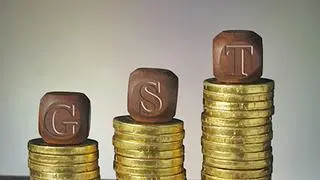Collection from Goods & Services Tax (GST) in June touched ₹1.74 lakh crore, registering around 8 per cent growth of June of last fiscal, official sources said on Monday. From now on, the Finance Ministry has discontinued releasing detailed GST collection data on day 1 of every month. This practice continued for 74 months. No reason has been given for discontinuing the release of monthly GST collection data.
Interestingly, the decision not to release monthly data coincided with the seventh anniversary of the new indirect tax system, which subsumed 17 taxes and 13 cesses of the Central and State Governments. Meanwhile, the Finance Ministry did come out with some data and statements through a series of social media posts to highlight achievements during the last seven years.
While June’s collection grew eight per cent year over year, it was flat month over month. May’s collection was ₹1.73 lakh crore. According to the latest figures, collection in the first three months has reached Rs 5.57 lakh crore. Sources said that better compliance and consumption have improved collection.
Earlier in the day, in a social media post, the Finance Ministry said that with reduced tax rates on household goods after implementation, seven years of GST has brought “happiness and relief to every home” through lower GST on household appliances and mobile phones. The Theme of 7th GST Day is Sashakt Vyapar Samagra Vikas (Empowered Trade, Overall Growth), the Ministry said.
GST compliance and taxpayer base
The GST taxpayer base has increased to 1.46 crore in April 2024 from 1.05 crore as of April 2018. “We have witnessed a quantum jump in taxpayers base along with improved compliance,” Central Board of Indirect Taxes and Customs (CBIC) Chairman Sanjay Kumar Agarwal said.
- Read: GST: A conciliatory way
Giving comparative charts of pre- and post-GST tax rates of household goods, the Ministry said GST has enhanced the ease of living with every household saving on expenditure on food items and items of mass consumption after GST implementation.
The rate of food items like unpacked wheat, rice, curd, and lassi, which were taxed at 2.5-4 per cent before GST implementation, is at nil after the GST rollout. Household goods like cosmetics, wristwatches, sanitary plastic ware, doors and windows, furniture and mattresses are taxed at a lower rate of 18 per cent in the GST regime, lower than 28 per cent in the erstwhile excise and VAT regime.
The ministry said mobile phones, TVs up to 32 inches, refrigerators, washing machines, electrical appliances (other than air conditioners), geysers and fans, which attracted 31.3 per cent taxes in the pre-GST era, are now in the 18 per cent tax slab in GST regime.
It further said the compliance burden was reduced for small taxpayers, and the GST Council has recommended to waive off annual return filing requirement for taxpayers with aggregate annual turnover of up to ₹2 crore in fiscal 2023-24.
The quarterly return filing and monthly payment of taxes (QRMP) scheme has reduced the number of returns filed in a year from 24 to 8 for more than 44 lakh small taxpayers; IFF (Invoice furnishing Facility) ensured the seamless passage of ITC (Input Tax Credit), the ministry added.






Comments
Comments have to be in English, and in full sentences. They cannot be abusive or personal. Please abide by our community guidelines for posting your comments.
We have migrated to a new commenting platform. If you are already a registered user of TheHindu Businessline and logged in, you may continue to engage with our articles. If you do not have an account please register and login to post comments. Users can access their older comments by logging into their accounts on Vuukle.